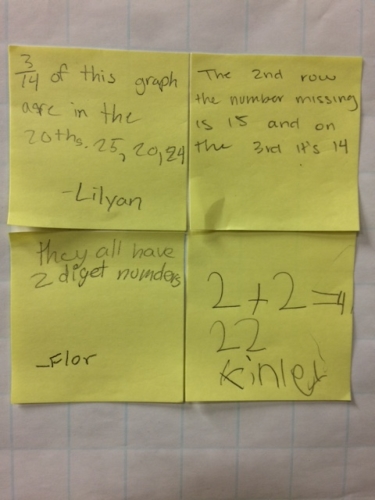
Primary students (K-2): counting, number recognition, comparing, geometric shapes
Intermediate students (3-5): even/odd numbers, addition/subtraction
In a magic square, all the rows, columns, and diagonals add to the same number. In our case, the numbers all add to 70. Usually, a magic square starts off with a few numbers filled in and participants figure out all the missing numbers. For this activity, though, I wanted participants to focus on the numbers in the grid so I only left two small squares empty.
At a beginning level, students can simply notice that there are numbers and point to numbers they recognize. They can count how many of each digit they see. Some of these students may even be able to "read" some of the double-digit numbers.
Some participants will notice squares. The grid is a 4 by 4 so there are 16 squares for numbers. (There are technically a lot more than 16 total squares and this may be a challenge to put out to the older students.)
Participants will no doubt notice that two small squares are missing a number. There are two ways to figure out what the missing number is.
1) Focusing on the columns, rows, and diagonals that are populated with four numbers, participants can add the four numbers to find that they each add to 70. The missing numbers, therefore, are 14 in the second row and 15 in the third row.
2) Participants notice that the numbers 10 - 25 are represented in the grid with the numbers 14 and 15 as the missing numbers. They need to determine which number belongs in which empty square. If they observe closely, they'll notice that each row, column, and diagonal consist of two even numbers and two odd numbers. Therefore, 14 must belong in the second row and 15 in the third row making two evens and two odds in each row, column, and diagonal.

"3/14 of this graph are in the 20s - 25, 20, 24 (This is not accurate but I like the idea of tying in fractions. I would want to know what his/her thinking was.)"
"The 2nd row the number missing is 15 and on the 3rd it’s 14."
"They all have two digit numbers."
"2 + 2 = 4; 22"